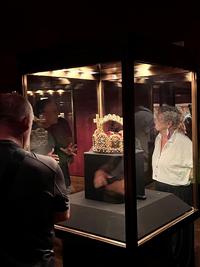Thanks to the generous support from the OOC DTP, I was able to spend three months at the Kunsthistorisches Museum (KHM) in Vienna doing a full-time placement with their Kunstkammer and Schatzkammer collections department. I had initially contacted one of the museum curators who I had been in touch with previously about my own research about the opportunity to come and do a placement with the department. Rebecca Costello from the DTP team was most helpful in answering my questions regarding creating my own placement at a museum abroad and the application process.
I was primarily assisting with an innovative interdisciplinary research project on the Imperial Crown and its materiality. Closely working with the project’s director Dr Franz Kirchweger, I researched comparative objects for epitaphic, stylistic and historic analysis. I really enjoyed using the research resources and internal database at the KHM not normally available to the public. I have now gained valuable skills in how such resources can be used in relation to the heritage sector. Moreover, it was really rewarding to present these interim results to the research project group and stimulate critical discussion of potential next steps. Another personal highlight was the editorial work and translations I did for an update of the project website. Each of the project’s sub-research circles put together a post on research questions guiding their work and most recent findings: https://www.projekt-reichskrone.at/en/
Beyond the research project, I really enjoyed getting insight into the various stages of putting together an exhibition. I was lucky to have the museum’s big autumn show open soon after I started my placement. This meant that I got to experience some of the final whirlwind preparations and the infectious excitement that goes along with this. It is then, that couriers arrive with loans from other institutions, objects are carefully placed in their display cases and labels are mounted on the walls – so many departments work together to make it all happen on time. I also sat in on some meetings that gave me a practical impression of the stages preceding this grand finale: talking to the museum’s exhibition production, marketing and events departments, finding the right architect to plan the space concept with the lead curator as well as negotiating with prospective lending institutions. For another exhibition I was given the opportunity to write three catalogue entries. Many days I was able to closely observe and, where possible, help with practical procedures closely connected to exhibition and display design as well as the custodianship of significant heritage objects not taught in my university syllabus.
The projects I followed and was involved in during my placement required collaborative working at all stages, be it with members of the curatorial team, the wider research project contributors or external partners. This allowed me to foster a deeper and more practical understanding of what it means to work in a large heritage institution like the KHM. I feel very lucky to have encountered so much kindness and generosity during this placement. So many colleagues took the time to really get to know me, answer my many questions and give me opportunities to grow as a young professional. This experience has made me more confident and aware of the practicalities this line of work involves, and I am sure it will proof invaluable in the future.

Photo by the Author